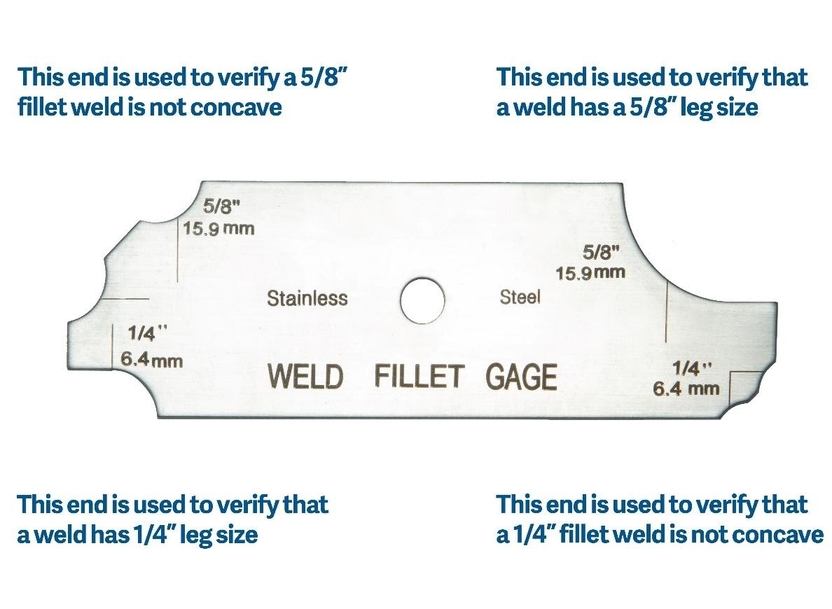The Ultimate Overview to Fillet Weld High Quality Control: Making Certain Strength and Durability in Your Welded Joints
In the world of welding, ensuring the stamina and durability of fillet welds is extremely important for the stability of welded joints. As we get started on this expedition of fillet weld quality control, we will reveal essential aspects that affect weld toughness, dig into effective examination techniques, and talk about techniques for stopping typical weld flaws.
Relevance of Fillet Weld High Quality Control
Guaranteeing appropriate fillet weld top quality control is extremely important in assuring the architectural integrity and long life of bonded components in various markets. Fillet welds are generally made use of in architectural steelwork, bridges, stress vessels, pipelines, and other crucial framework where the toughness of the weld is important to overall safety and performance. Quality assurance measures such as visual assessments, non-destructive testing, and adherence to welding treatments aid recognize potential issues like absence of combination, incomplete penetration, undercutting, or excessive reinforcement.
Key Aspects Impacting Weld Strength
Accomplishing ideal weld toughness requires mindful consideration of different vital aspects that influence the stability and sturdiness of the welded joint. The very first critical variable appertains joint preparation, which includes cleansing the base steels to eliminate any kind of impurities that can damage the weld. Furthermore, the fit-up of the joint is vital to make sure correct infiltration and blend of the filler product.
The selection of the suitable welding strategy and parameters likewise plays a considerable role in establishing weld toughness. Elements such as heat input, traveling speed, and electrode angle can impact the top quality of the weld. Additionally, preserving the correct interpass temperature throughout multi-pass welding is vital to stop breaking and ensure a solid bond between the layers.
Additionally, the choice of filler material and its compatibility with the base metals is vital for accomplishing high weld toughness. Using filler product with the suitable mechanical homes can enhance the total integrity of the weld. Last but not least, post-weld warmth treatment and correct examination methods are vital actions in making certain the toughness and resilience of the bonded joint.
Evaluation Approaches for Weld Stability

One more critical evaluation technique is liquid penetrant screening, where a fluid color is used to the weld surface - Gauge Fillet Weld. The dye seeps right into any type of surface-breaking defects, making them visible under UV light. This approach is efficient for spotting problems that might not be noticeable to the naked eye


Ultrasonic screening is also extensively made use of for checking weld integrity. High-frequency sound waves are directed into the weld, and any type of disruptions in the acoustic wave pattern indicate possible defects like cracks or lack of fusion.
These evaluation methods play an essential function in making sure the high quality and dependability of welds, eventually contributing to the total stamina and sturdiness of bonded joints in commercial settings.
Avoiding Typical Weld Issues
In order to maintain the structural stability of welded joints in commercial applications, it is vital to try this apply preventative measures to resolve usual weld flaws. One common flaw is absence of fusion, where the filler material falls short to bond properly with the base steels, resulting in vulnerable points in the weld. This can be prevented by making sure proper heat control and utilizing the right welding method.
One more frequent concern is porosity, brought on by gas entrapment in the weld metal during the welding procedure. To avoid this, it is crucial to clean up the base metals extensively, utilize completely dry electrodes, and keep a suitable welding environment with correct ventilation.
In addition, splits in welds can endanger the joint's stamina. To prevent this issue, it is very important to control the air conditioning price after welding, utilize pre-heating when necessary, and select suitable welding specifications.
Enhancing Bonded Durability With Proper Techniques
One vital technique to improve weld durability is to make certain correct weld grain positioning. By placing the weld grain accurately within the joint, the weld's strength and resistance to fatigue can be dramatically enhanced.
Selecting the best filler metal and guaranteeing the cleanliness of the base metals can stop incorporations and other defects that could jeopardize the weld's longevity. By implementing these appropriate strategies, welders can guarantee that their bonded joints exhibit outstanding stamina and sturdiness, meeting the greatest high quality requirements.
Verdict
In verdict, keeping high top quality control criteria for fillet welds is essential for making certain the stamina and longevity of bonded joints. By understanding the crucial variables impacting weld published here stamina, utilizing evaluation techniques for weld stability, preventing typical weld flaws, and employing correct methods, welders can enhance the overall toughness of their welds. It is necessary to focus on quality assurance measures to produce resilient and trustworthy welded joints.
In the world of welding, guaranteeing the toughness and resilience of fillet welds is vital for the stability of bonded joints. As we get started on this expedition of fillet weld high quality control, we will certainly discover important variables that influence weld strength, delve into effective examination methods, and review methods useful site for stopping usual weld defects.Attaining ideal weld toughness requires mindful consideration of different key factors that influence the stability and durability of the bonded joint (Gauge Fillet Weld).In conclusion, keeping high top quality control criteria for fillet welds is important for guaranteeing the strength and longevity of bonded joints. By recognizing the key variables affecting weld stamina, using evaluation methods for weld honesty, stopping common weld issues, and using correct methods, welders can enhance the general resilience of their welds